App SSO Node
This app talks about the Teams Tab, Bot, Messaging Extension - search, action, linkunfurl SSO with Node JS
Tab SSO This sample shows how to implement Azure AD single sign-on support for tabs. It will
- Obtain an access token for the logged-in user using SSO
- Call a web service - also part of this project - to exchange this access token
- Call Graph and retrieve the user's profile
Bot, ME SSO Bot Framework v4 bot using Teams authentication
This bot has been created using Bot Framework, it shows how to get started with authentication in a bot for Microsoft Teams.
The focus of this sample is how to use the Bot Framework support for oauth in your bot. Teams behaves slightly differently than other channels in this regard. Specifically an Invoke Activity is sent to the bot rather than the Event Activity used by other channels. This Invoke Activity must be forwarded to the dialog if the OAuthPrompt is being used. This is done by subclassing the ActivityHandler and this sample includes a reusable TeamsActivityHandler. This class is a candidate for future inclusion in the Bot Framework SDK.
The sample uses the bot authentication capabilities in Azure Bot Service, providing features to make it easier to develop a bot that authenticates users to various identity providers such as Microsoft Entra ID, GitHub, Uber, etc. The OAuth token is then used to make basic Microsoft Graph queries. Refer the SSO setup documentation.
IMPORTANT: The manifest file in this app adds "token.botframework.com" to the list of
validDomains. This must be included in any bot that uses the Bot Framework OAuth flow.
Included Features
- Teams SSO (bots, tabs, messaging extensions, link unfurling)
- Adaptive Cards
- MSAL.js 2.0 support
Interaction with app
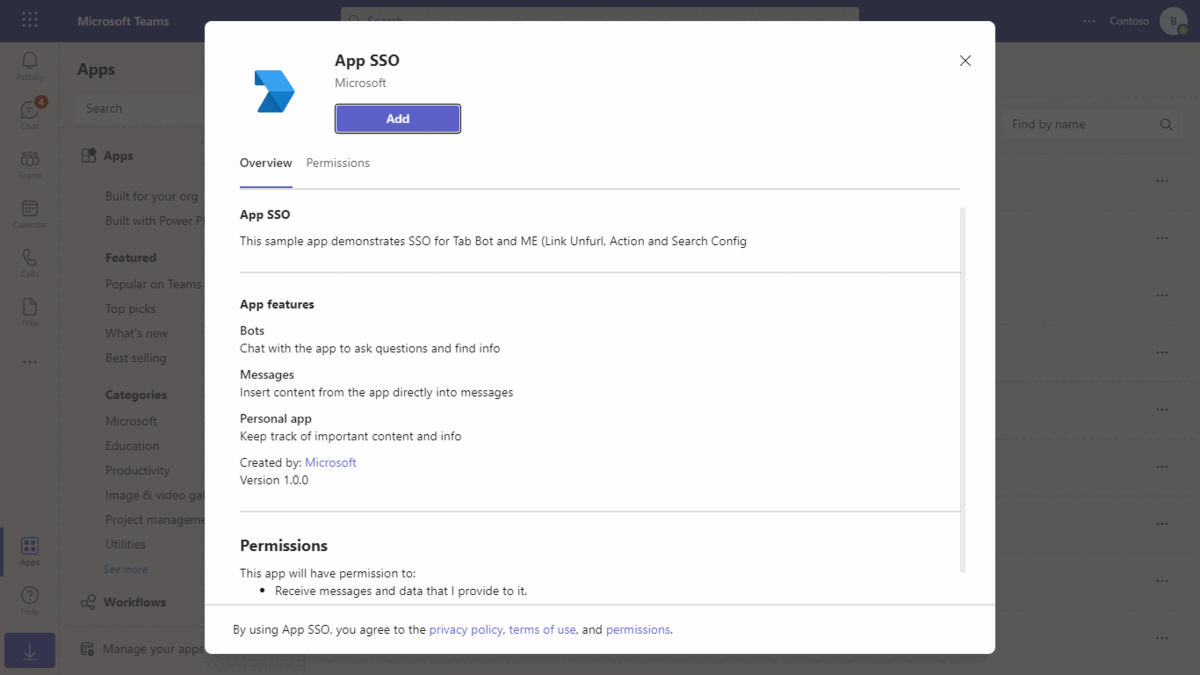
Try it yourself - experience the App in your Microsoft Teams client
Please find below demo manifest which is deployed on Microsoft Azure and you can try it yourself by uploading the app package (.zip file link below) to your teams and/or as a personal app. (Sideloading must be enabled for your tenant, see steps here).
App SSO: Manifest
Prerequisites
To test locally, NodeJS must be installed on your development machine (version 16.14.2 or higher).
# determine node version node --versiondev tunnel or ngrok latest version or equivalent tunnelling solution
A global administrator account for an Office 365 tenant. Testing in a production tenant is not recommended! You can get a free tenant for development use by signing up for the Office 365 Developer Program (not a guest account).
To test locally, you'll need Ngrok or dev tunnel installed on your development machine. If you use Ngrok, make sure you've downloaded and installed Ngrok on your local machine. ngrok will tunnel requests from the Internet to your local computer and terminate the SSL connection from Teams.
NOTE: The free ngrok plan will generate a new URL every time you run it, which requires you to update your Azure AD registration, the Teams app manifest, and the project configuration. A paid account with a permanent ngrok URL is recommended.
- M365 developer account or access to a Teams account with the appropriate permissions to install an app.
1. Setup for Bot
Setup for Bot SSO Refer to Bot SSO Setup document.
Ensure that you've enabled the Teams Channel
2. Setup NGROK
Run ngrok - point to port 3978
ngrok http 3978 --host-header="localhost:3978"Alternatively, you can also use the
dev tunnels. Please follow Create and host a dev tunnel and host the tunnel with anonymous user access command as shown below:devtunnel host -p 3978 --allow-anonymous
3. Setup for code
Clone the repository
git clone https://github.com/OfficeDev/Microsoft-Teams-Samples.gitIn a terminal, navigate to
mples/app-sso/nodejsInstall modules & Run the
NodeJSServer- Server will run on PORT:
4001 - Open a terminal and navigate to project root directory
npm run serverThis command is equivalent to: npm install > npm run build-client > npm start
- Server will run on PORT:
Install modules & Run the
ReactClient- Client will run on PORT:
3978 - Open a terminal and navigate to project root directory
npm run client> **This command is equivalent to:** _cd client > npm install > npm start- Client will run on PORT:
Update the
.envconfiguration for the bot to use theMicrosoftAppId(Microsoft App Id),MicrosoftAppPassword(App Password) andconnectionName(OAuth Connection Name) from the Azure Bot registration.NOTE: the App Password is referred to as the
client secretin the azure portal and you can always create a new client secret anytime.
Bot Configuration:

Bot OAuth Connection:
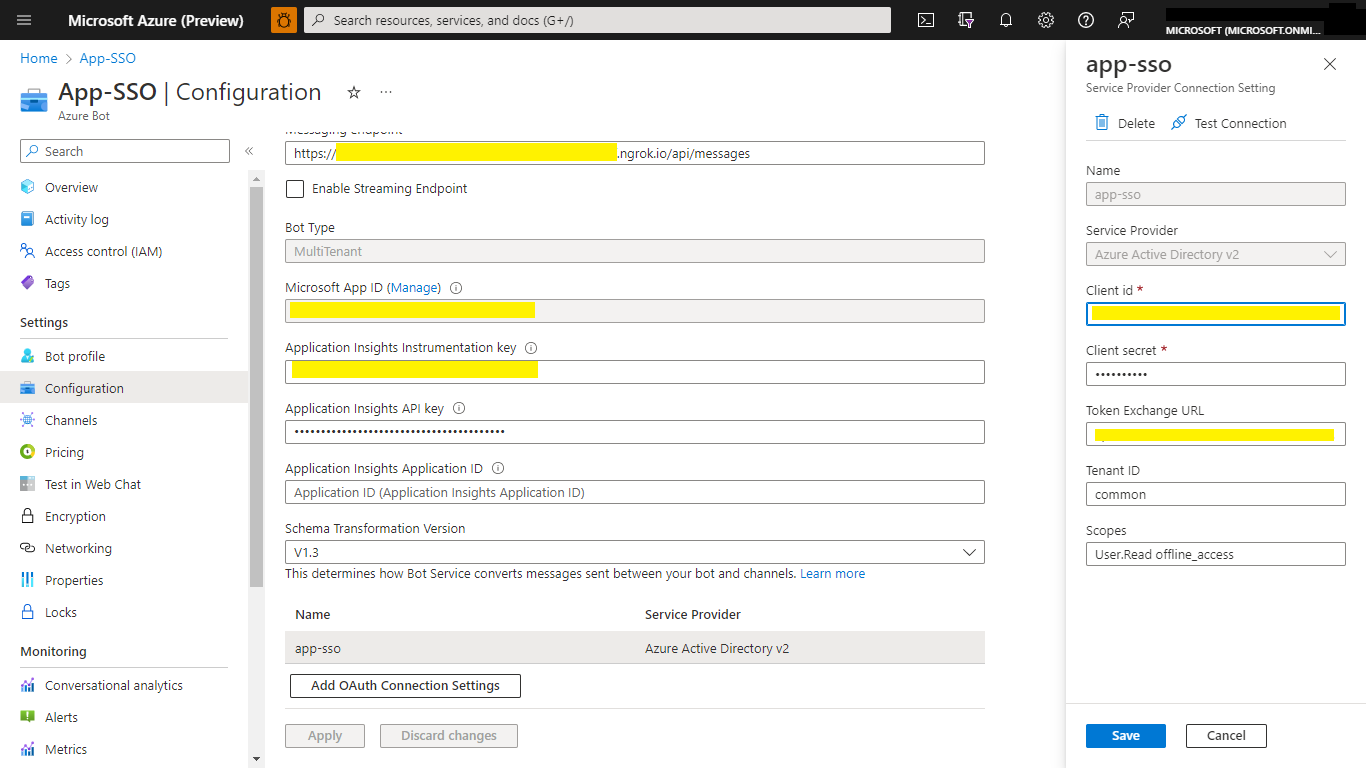
4. Register your Teams Auth SSO with Azure AD
- Register a new application in the Microsoft Entra ID – App Registrations portal.
- Select New Registration and on the register an application page, set following values:
- Set name to your app name.
- Choose the supported account types (any account type will work)
- Leave Redirect URI empty.
- Choose Register.
- On the overview page, copy and save the Application (client) ID, Directory (tenant) ID. You’ll need those later when updating your Teams application manifest and in the appsettings.json.
- Under Manage, select Expose an API.
- Select the Set link to generate the Application ID URI in the form of
api://{AppID}. Insert your fully qualified domain name (with a forward slash "/" appended to the end) between the double forward slashes and the GUID. The entire ID should have the form of:api://fully-qualified-domain-name/botid-{AppID}- ex:
api://%ngrokDomain%.ngrok-free.app/botid-00000000-0000-0000-0000-000000000000.
- ex:
- Select the Add a scope button. In the panel that opens, enter
access_as_useras the Scope name. - Set Who can consent? to
Admins and users - Fill in the fields for configuring the admin and user consent prompts with values that are appropriate for the
access_as_userscope:- Admin consent title: Teams can access the user’s profile.
- Admin consent description: Allows Teams to call the app’s web APIs as the current user.
- User consent title: Teams can access the user profile and make requests on the user's behalf.
- User consent description: Enable Teams to call this app’s APIs with the same rights as the user.
- Ensure that State is set to Enabled
- Select Add scope
- The domain part of the Scope name displayed just below the text field should automatically match the Application ID URI set in the previous step, with
/access_as_userappended to the end:- `api://[ngrokDomain].ngrok-free.app/00000000-0000-0000-0000-000000000000/access_as_user.
- The domain part of the Scope name displayed just below the text field should automatically match the Application ID URI set in the previous step, with
- In the Authorized client applications section, identify the applications that you want to authorize for your app’s web application. Each of the following IDs needs to be entered:
1fec8e78-bce4-4aaf-ab1b-5451cc387264(Teams mobile/desktop application)5e3ce6c0-2b1f-4285-8d4b-75ee78787346(Teams web application) Note If you want to test or extend your Teams apps across Office and Outlook, kindly add below client application identifiers while doing Azure AD app registration in your tenant:
4765445b-32c6-49b0-83e6-1d93765276ca(Office web)0ec893e0-5785-4de6-99da-4ed124e5296c(Office desktop)bc59ab01-8403-45c6-8796-ac3ef710b3e3(Outlook web)d3590ed6-52b3-4102-aeff-aad2292ab01c(Outlook desktop)
- Navigate to API Permissions, and make sure to add the follow permissions:
- Select Add a permission
- Select Microsoft Graph -> Delegated permissions.
- User.Read (enabled by default)
- offline_access
- OpenId
- profile
- Click on Add permissions. Please make sure to grant the admin consent for the required permissions.
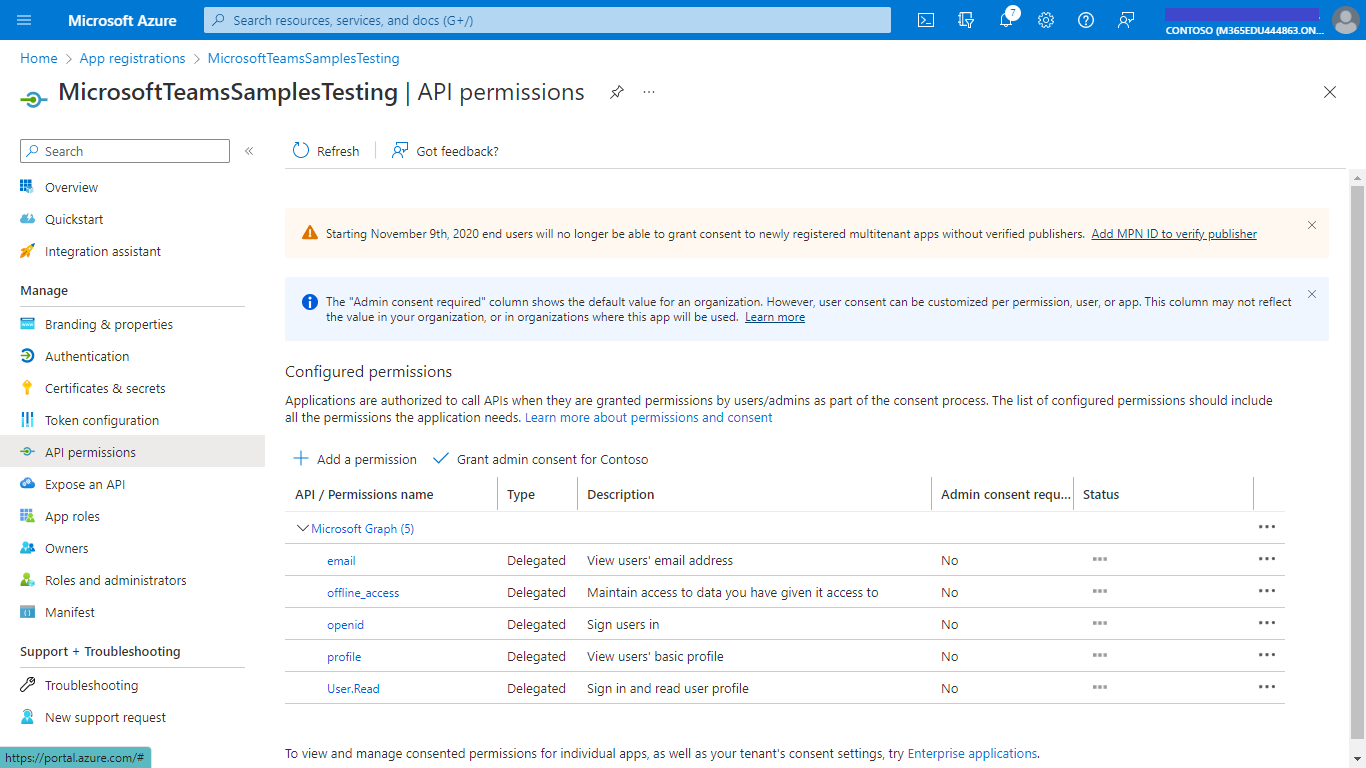
Navigate to Authentication If an app hasn't been granted IT admin consent, users will have to provide consent the first time they use an app. Set a redirect URI:
- Select Add a platform.
- Select web.
- Enter the redirect URI for the app in the following format:
- https://%ngrokDomain%.ngrok-free.app/Auth/End
- https://token.botframework.com/.auth/web/redirect
Enable implicit grant by checking the following boxes:
✔ ID Token
✔ Access Token

Navigate to the Certificates & secrets. In the Client secrets section, click on "+ New client secret". Add a description (Name of the secret) for the secret and select “Never” for Expires. Click "Add". Once the client secret is created, copy its value, it need to be placed in the appsettings.json.
6. Setup Manifest for Teams
- This step is specific to Teams.
- Edit the
manifest.jsoncontained in theteamsAppManifestfolder to replace your Microsoft App Id (that was created when you registered your bot earlier) everywhere you see the place holder string<<YOUR-MICROSOFT-APP-ID>>(depending on the scenario the Microsoft App Id may occur multiple times in themanifest.json) also update the<<DOMAIN-NAME>>with base Url domain. E.g. if you are using ngrok it would behttps://1234.ngrok-free.appthen your domain-name will be1234.ngrok-free.appand if you are using dev tunnels then your domain will be like:12345.devtunnels.ms. - Note: If you want to test your app across multi hub like: Outlook/Office.com, please update the
manifest.jsonin theapp-sso\nodejsfolder with the required values. - Zip up the contents of the
teamsAppManifestfolder to create amanifest.ziporManifest_Hub - Upload the
manifest.zipto Teams (in the Apps view click "Upload a custom app")
- Edit the
Note: This manifest.json specified that the bot will be installed in a "personal" scope only. Please refer to Teams documentation for more details.
- If you are facing any issue in your app, please uncomment this line and put your debugger for local debug.
Running the sample
You can interact with this bot by sending it a message. The bot will respond by requesting you to login to Microsoft Entra ID, then making a call to the Graph API on your behalf and returning the results.
Install App:
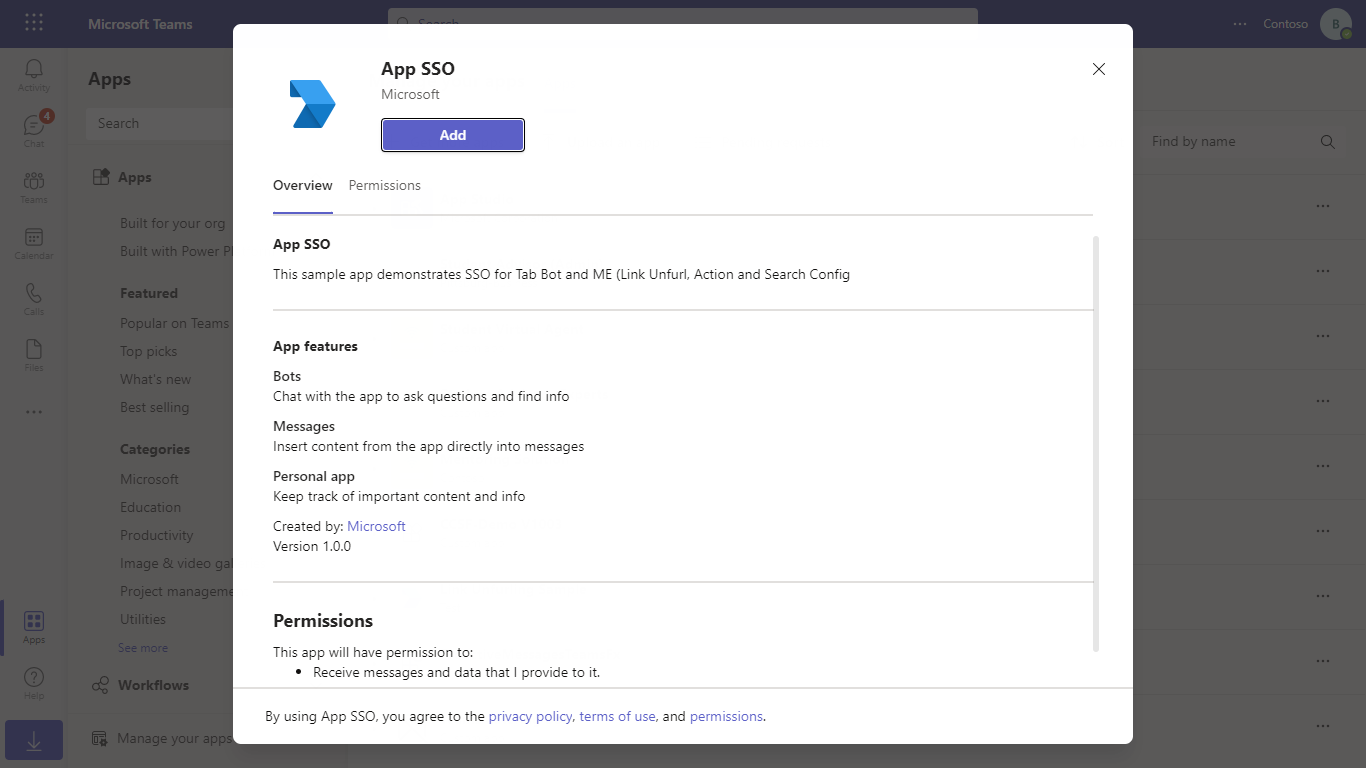
Welcome Card:

- Type anything on the compose box and send
- The bot will perform
Single Sign-Onand Profile card will be displayed along with the option prompt to view thetoken
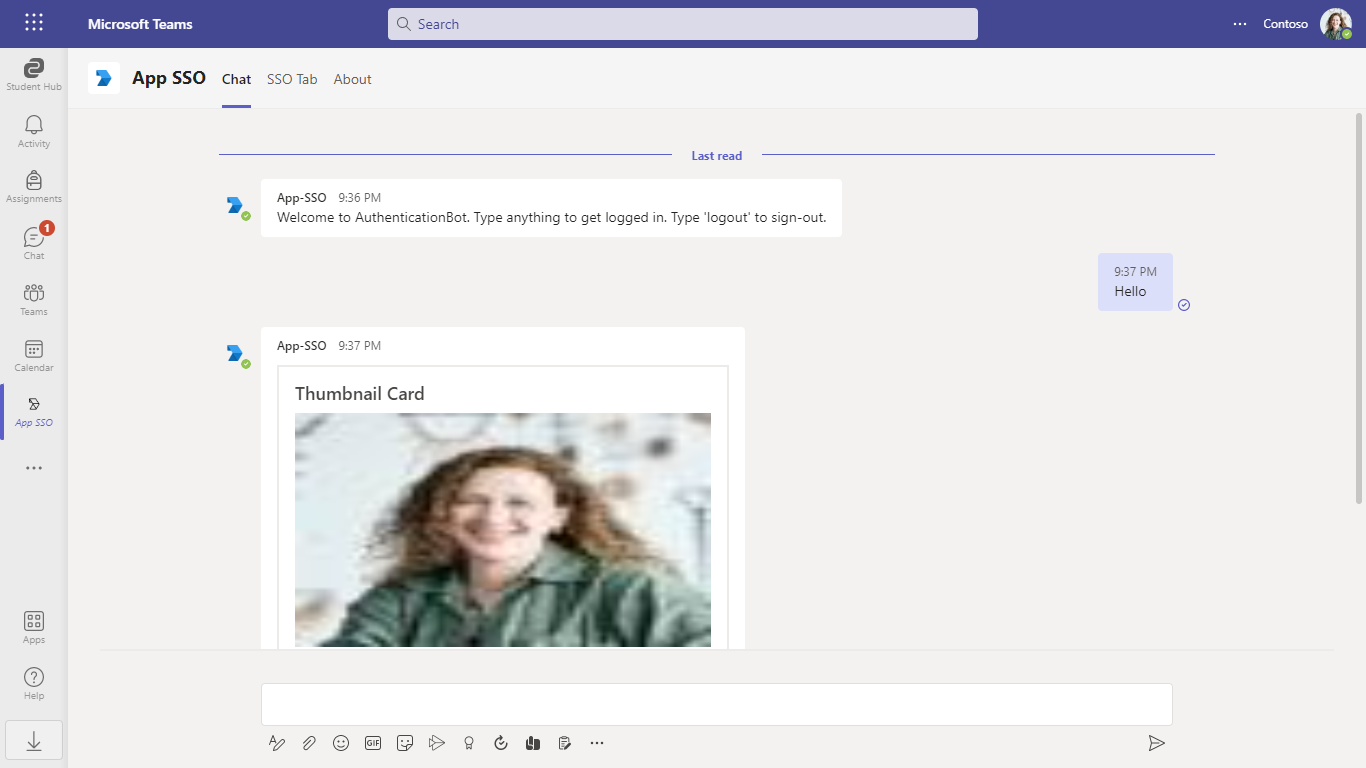
Would you like to view your token:
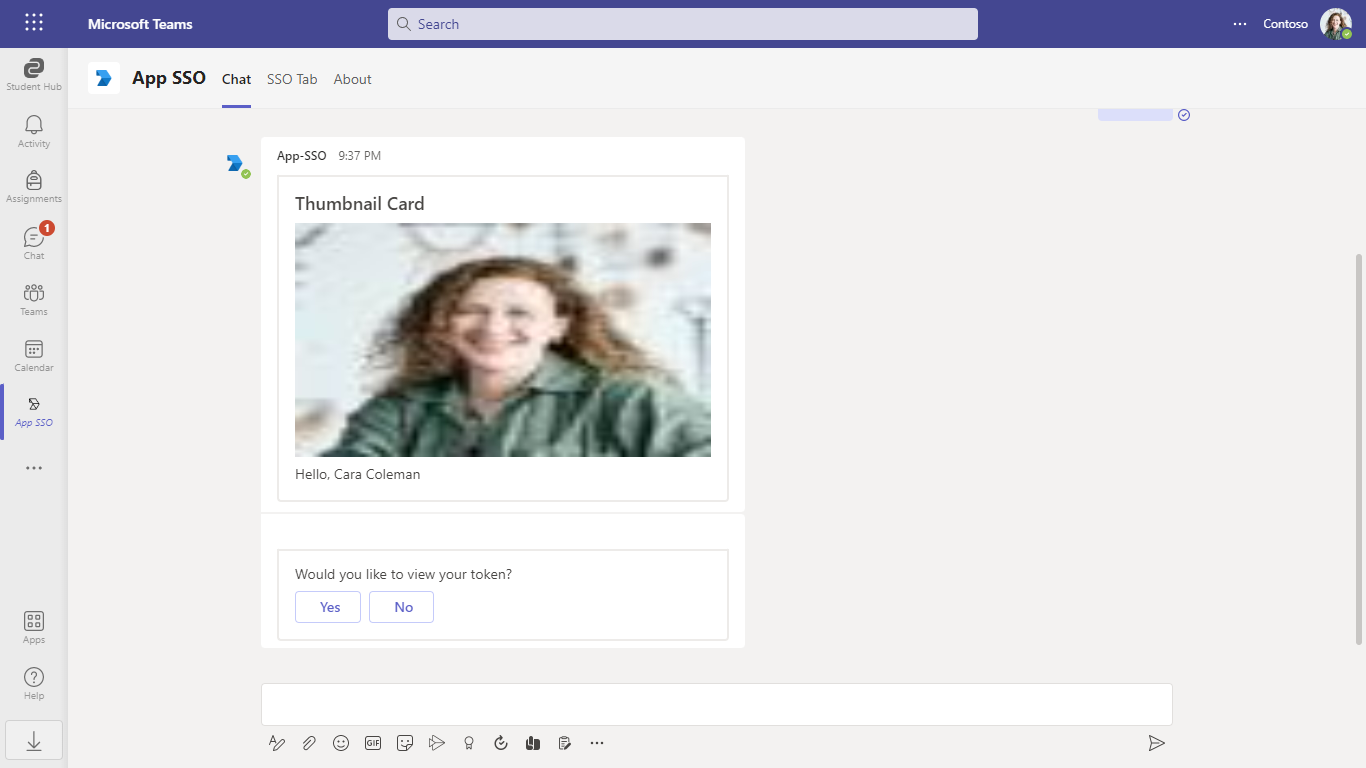
Click token Yes:
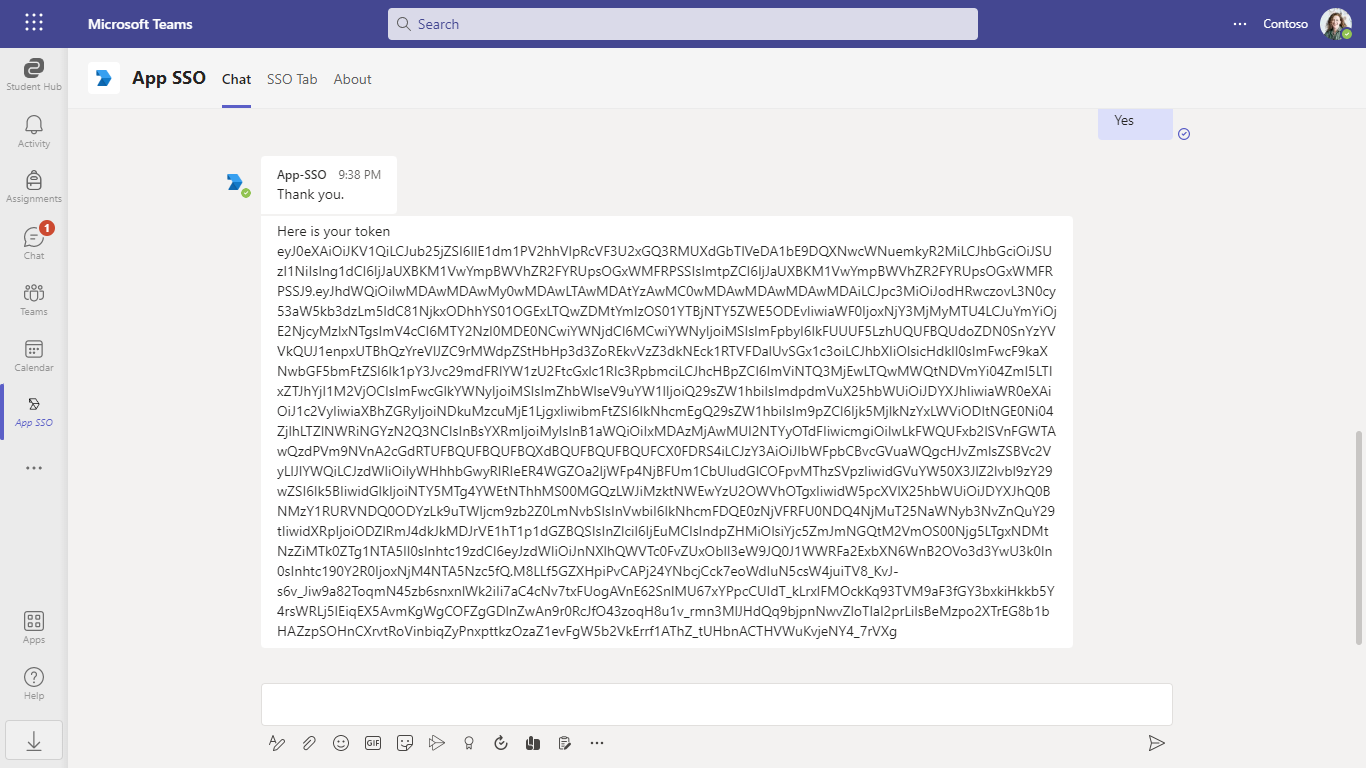
Open Messaging Extension (Search), it will show profile details:
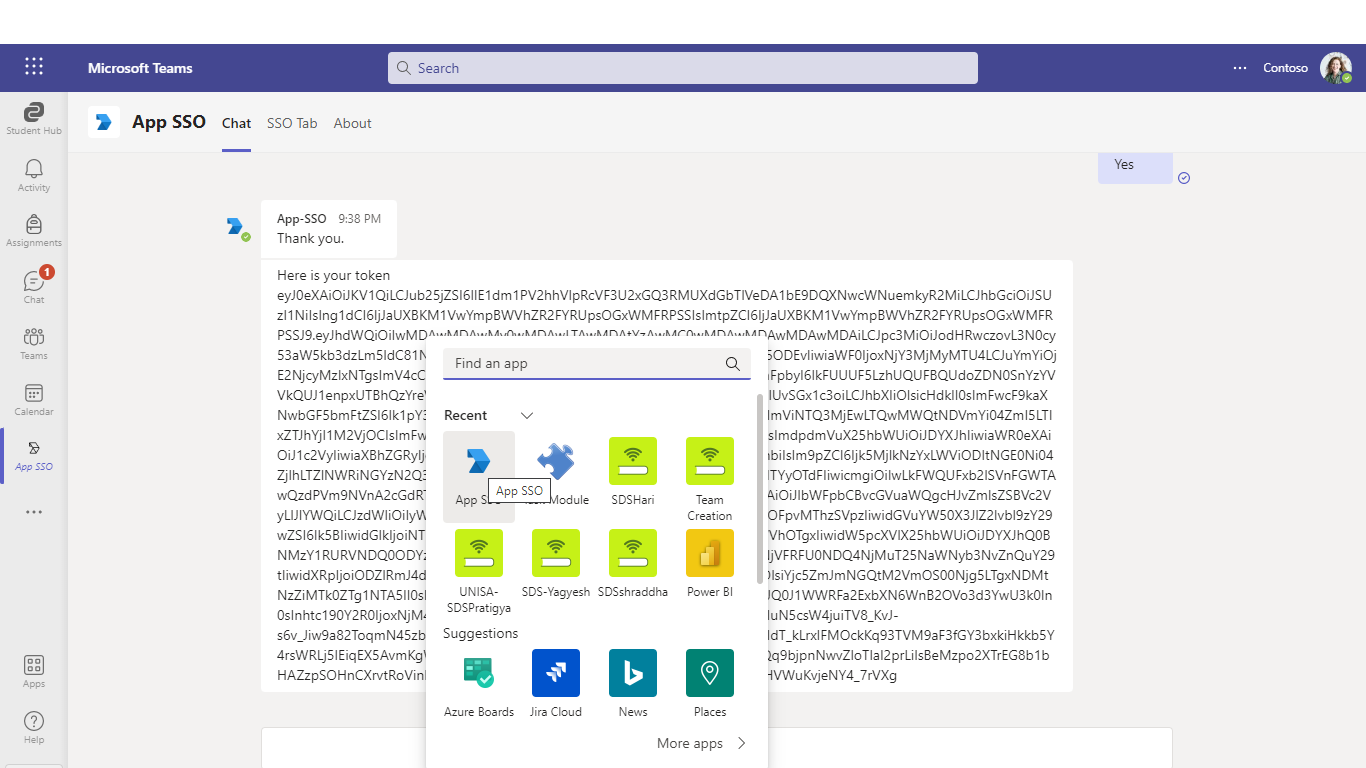
Open App SSO
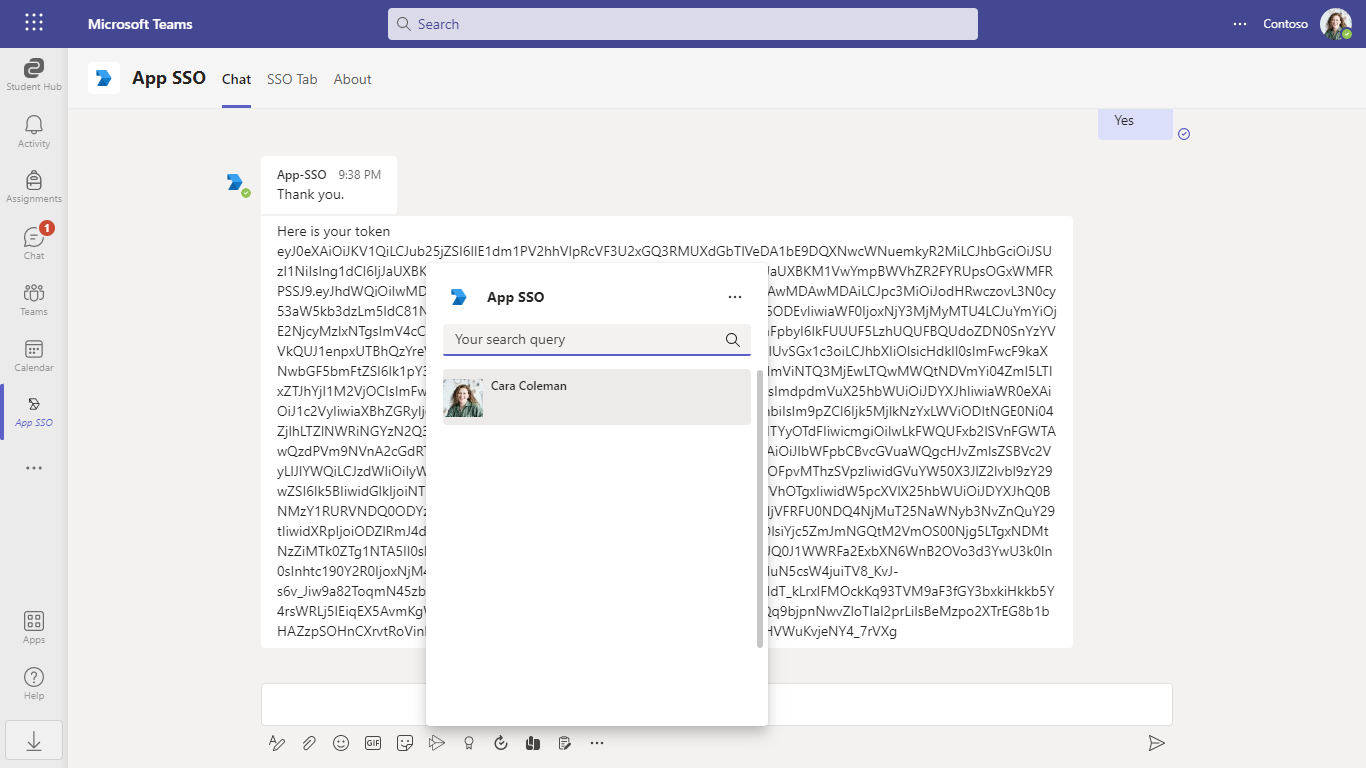
Open Messaging Extension (Action), it will show profile details:
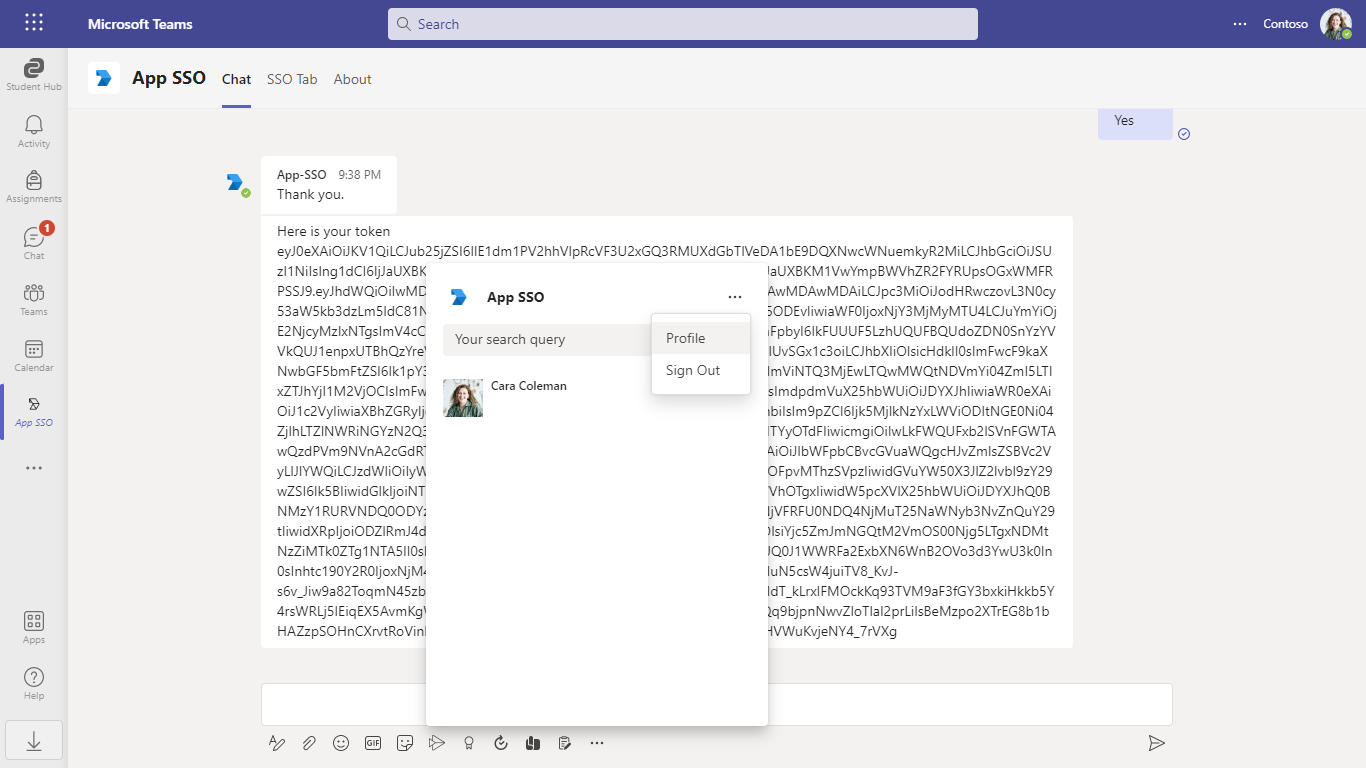
Click profile UI:

Select profile UI:
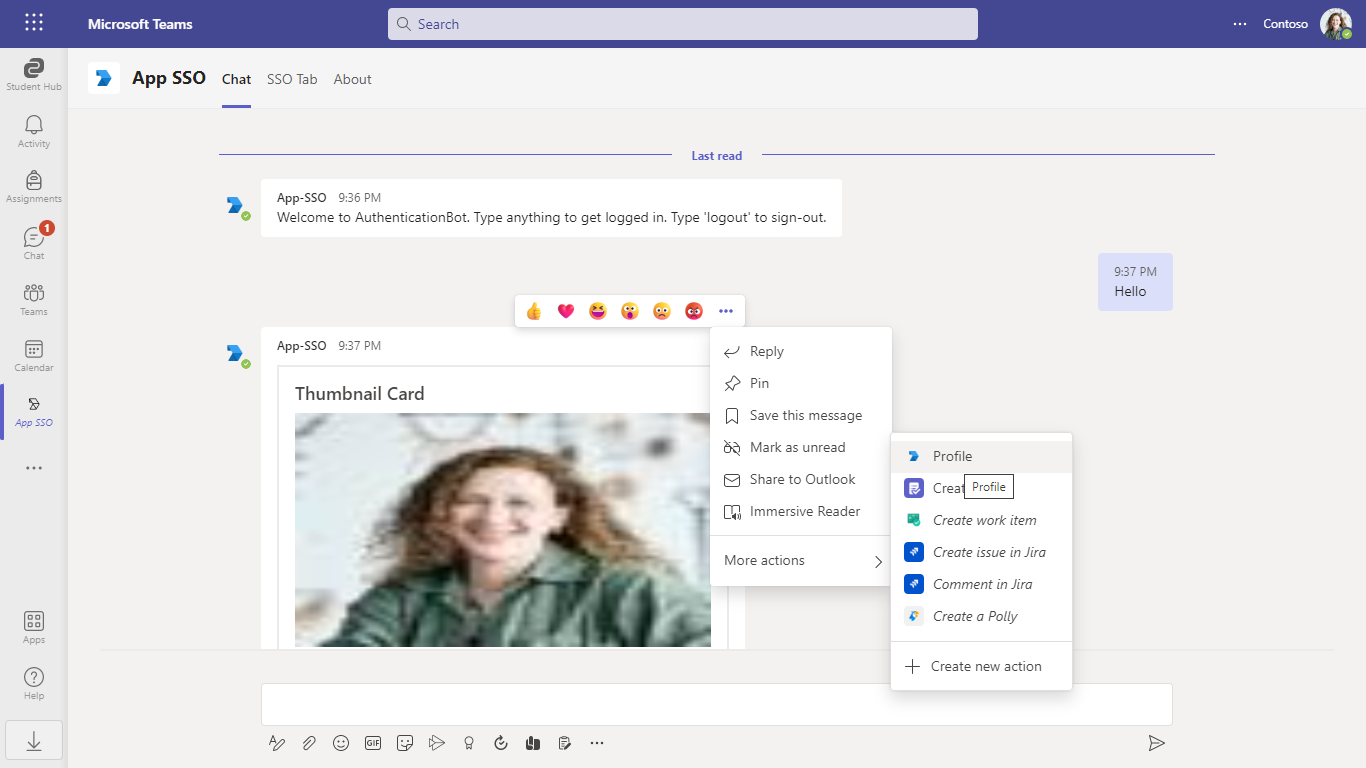
Click profile UI:
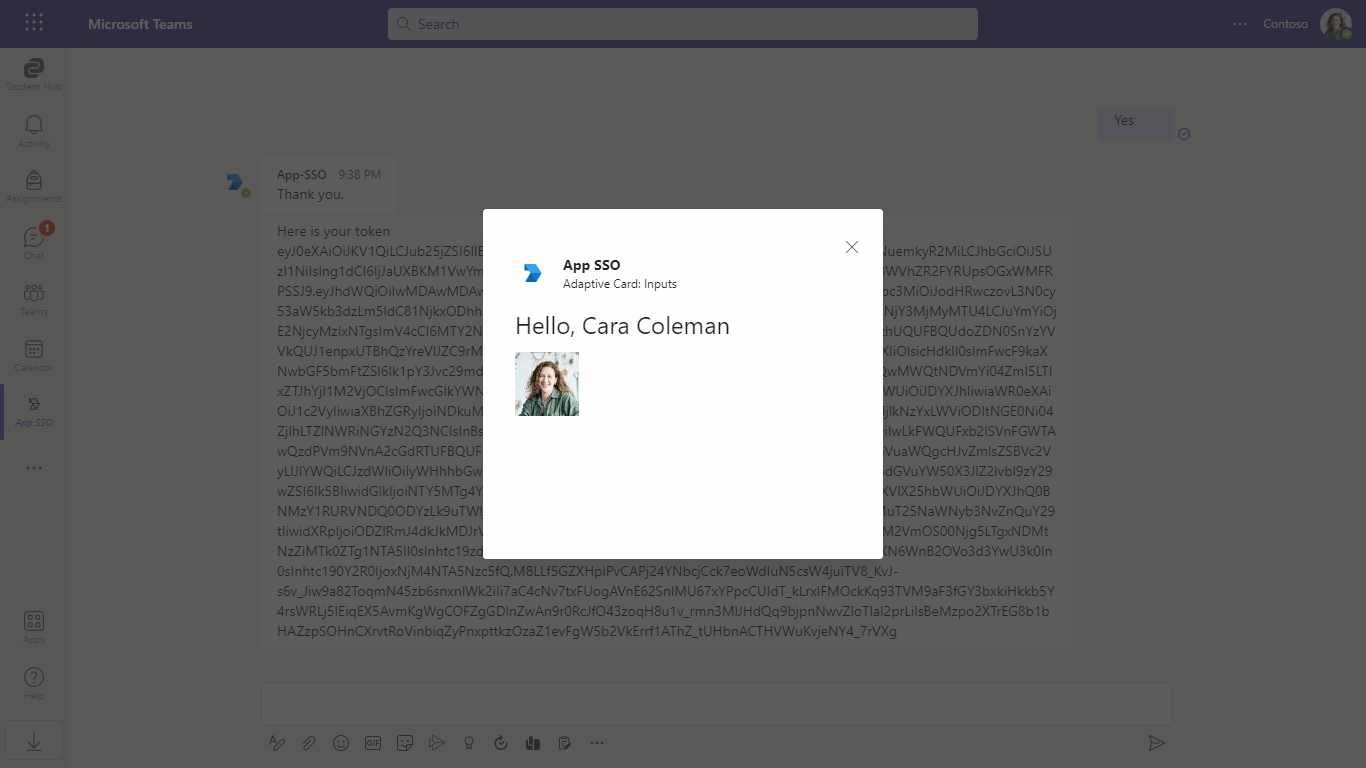
Open Messaging Extension (linkunfurl), The link will unfurl and show profile details:
Paste https://profile.botframework.com on the compose box
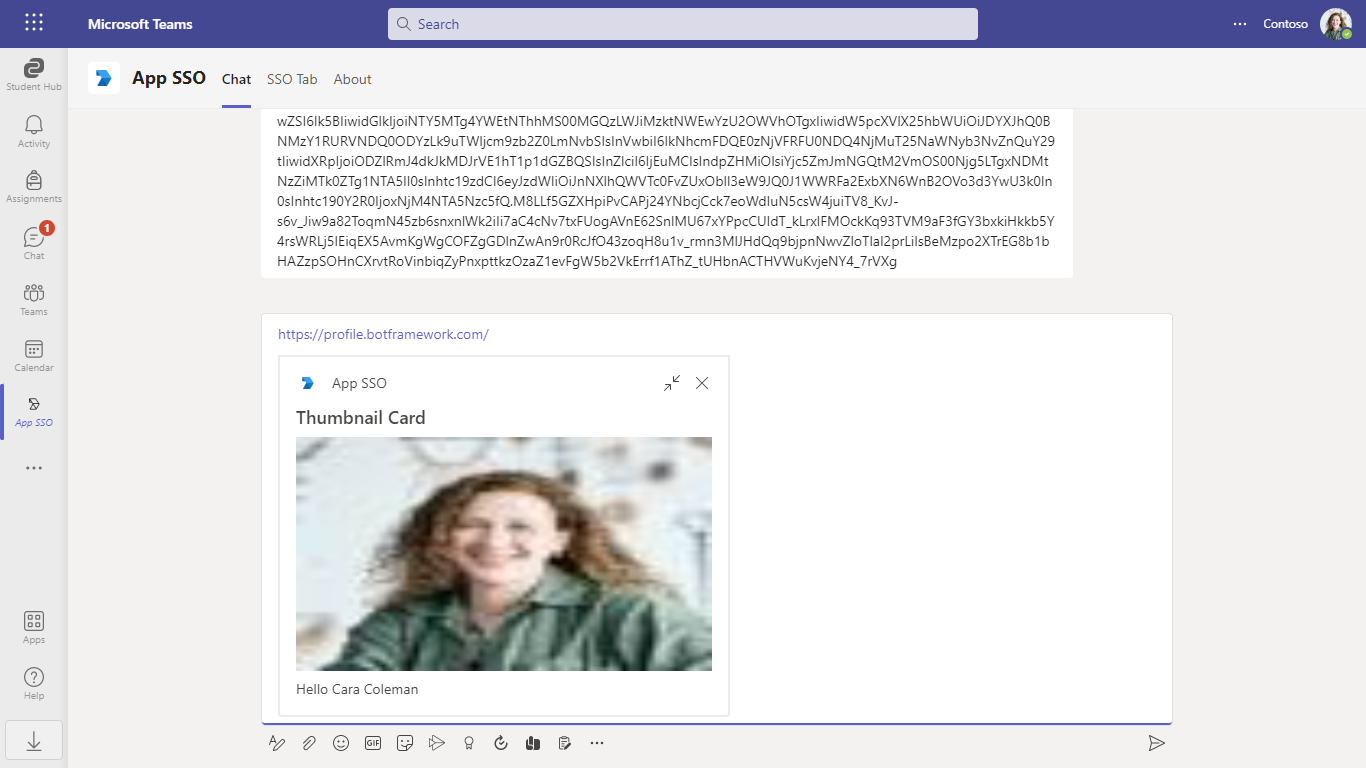
Open SSO Tab Continue and then Accept and it'll show the profile details:

Install app other tenant:
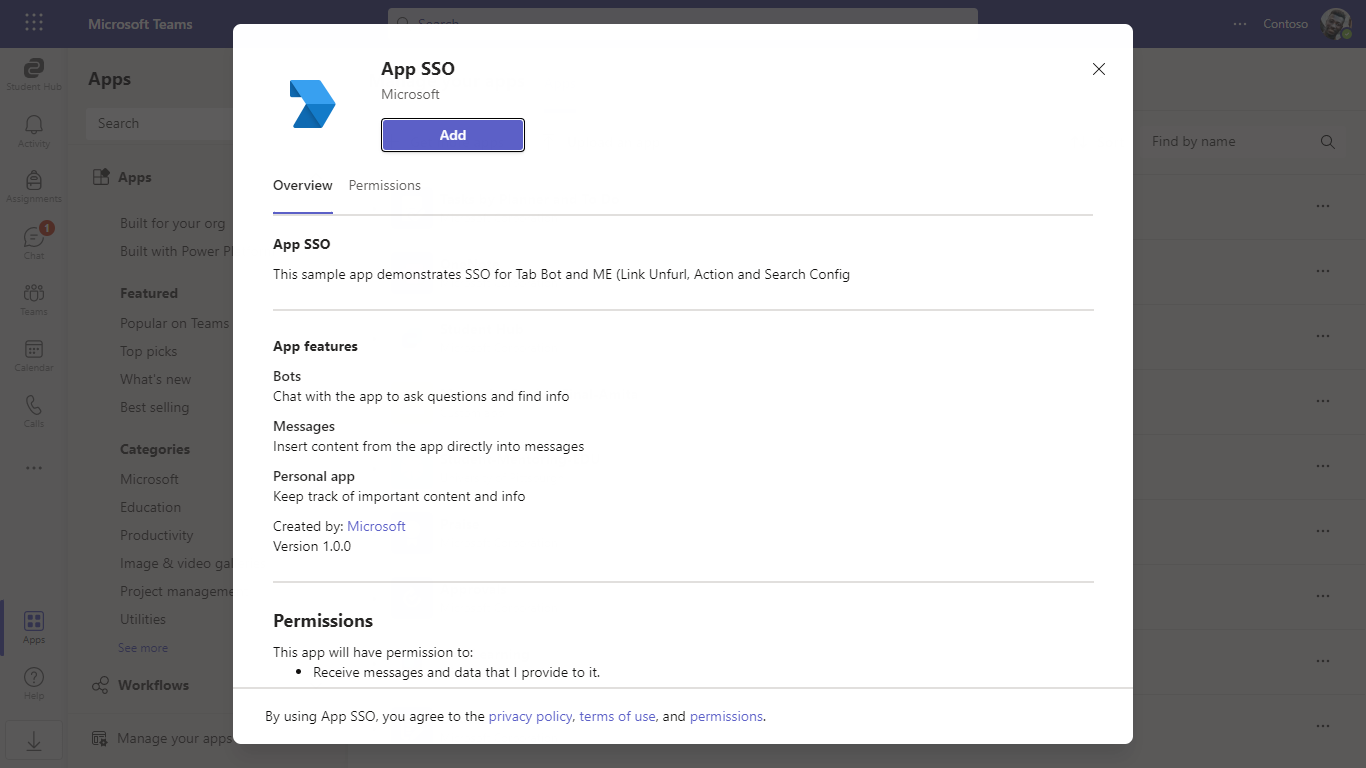
NOTE: If
SSOcouldn't be performed then it will fallback to normal Authentication method and you will get a defaultSign Inaction
Consent the ME Search by clicking the Sign In link like below:
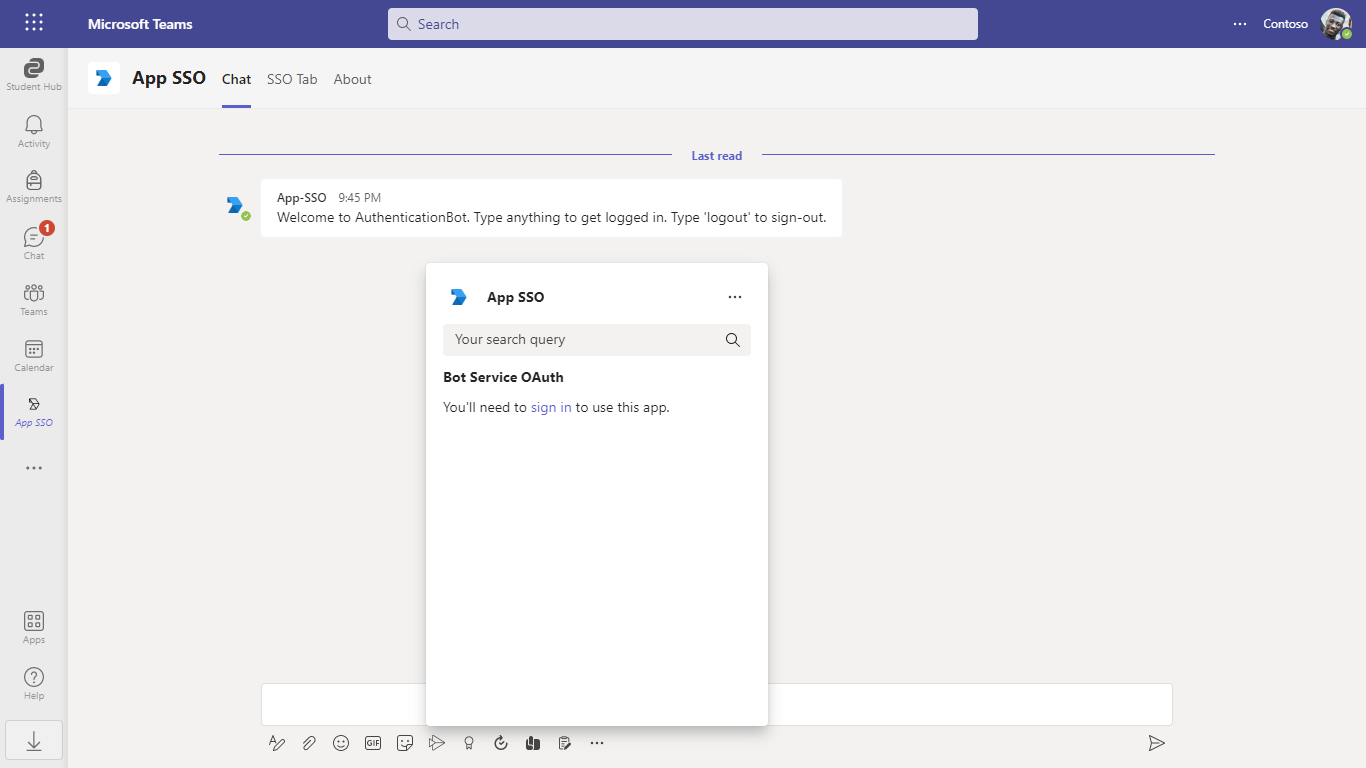
Consent the ME Action by clicking the Setup button like below:
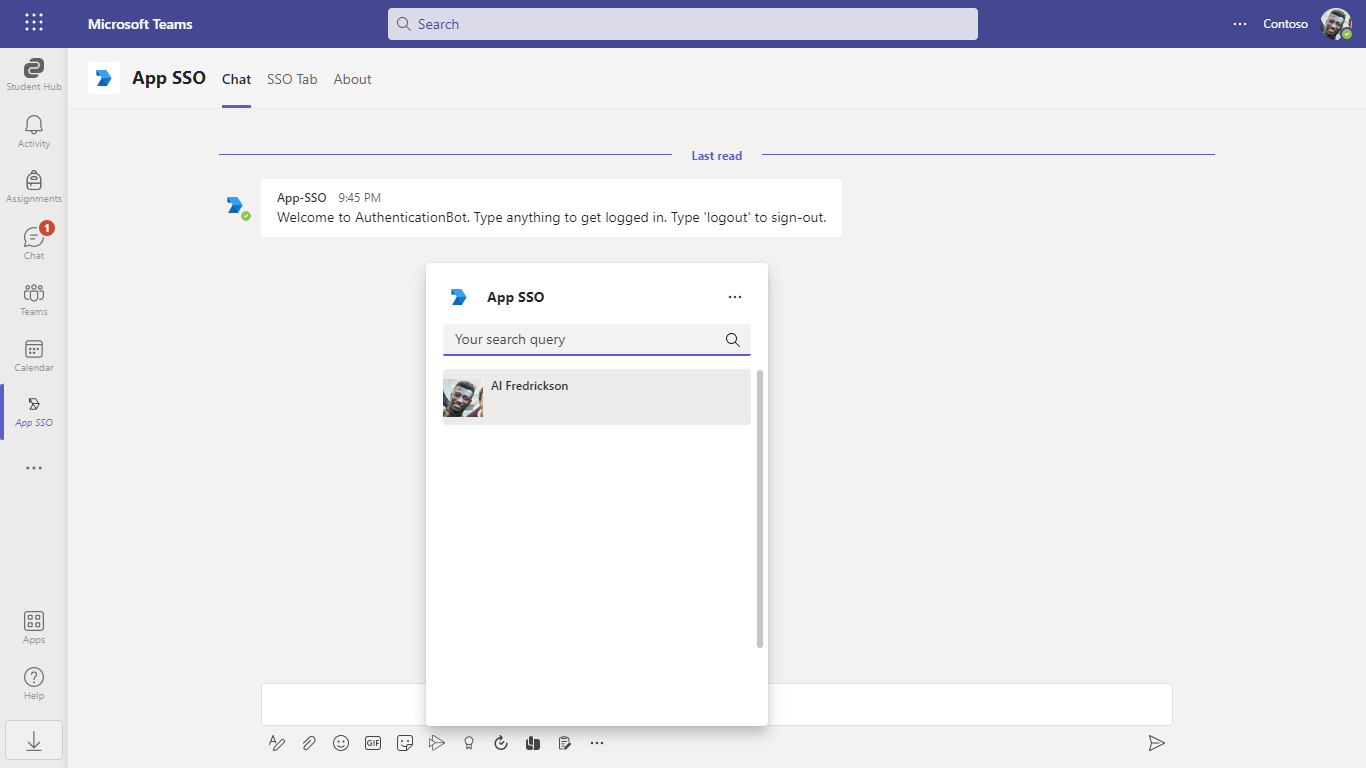
Outlook on the web
To view your app in Outlook on the web.
Go to Outlook on the weband sign in using your dev tenant account.
On the side bar, select More Apps. Your sideloaded app title appears among your installed apps
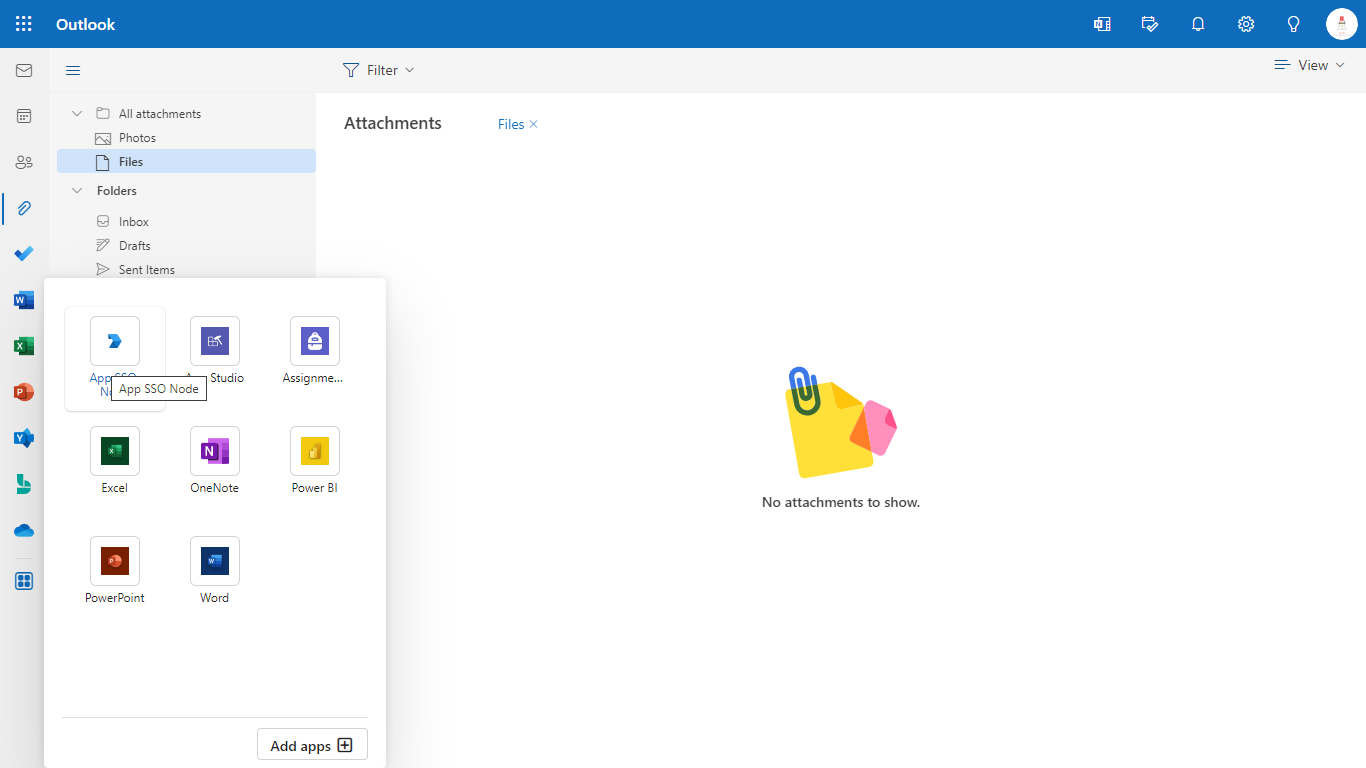
Select your app icon to launch and preview your app running in Outlook on the web
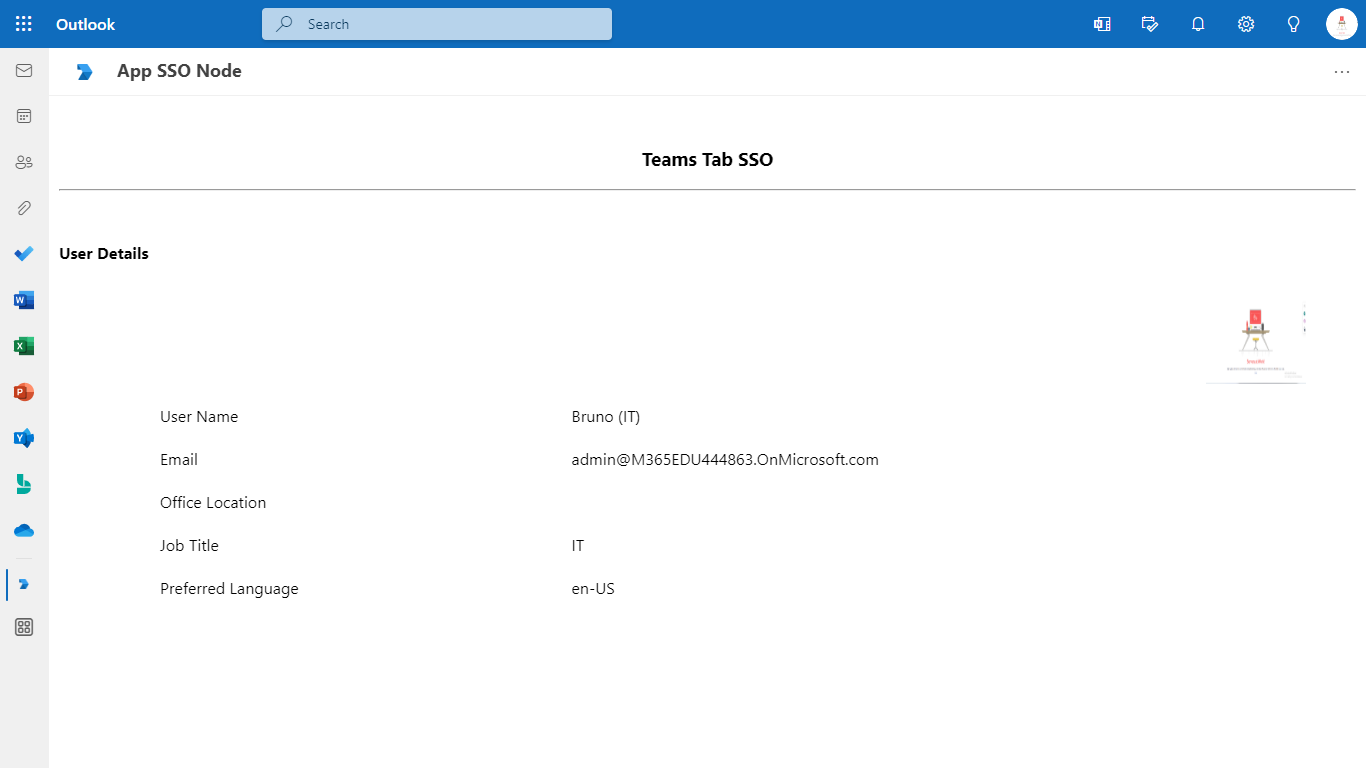
Note: Similarly, you can test your application in the Outlook desktop app as well.
Office on the web
To preview your app running in Office on the web.
Log into office.com with test tenant credentials
Select the Apps icon on the side bar. Your sideloaded app title appears among your installed apps

Select your app icon to launch your app in Office on the web
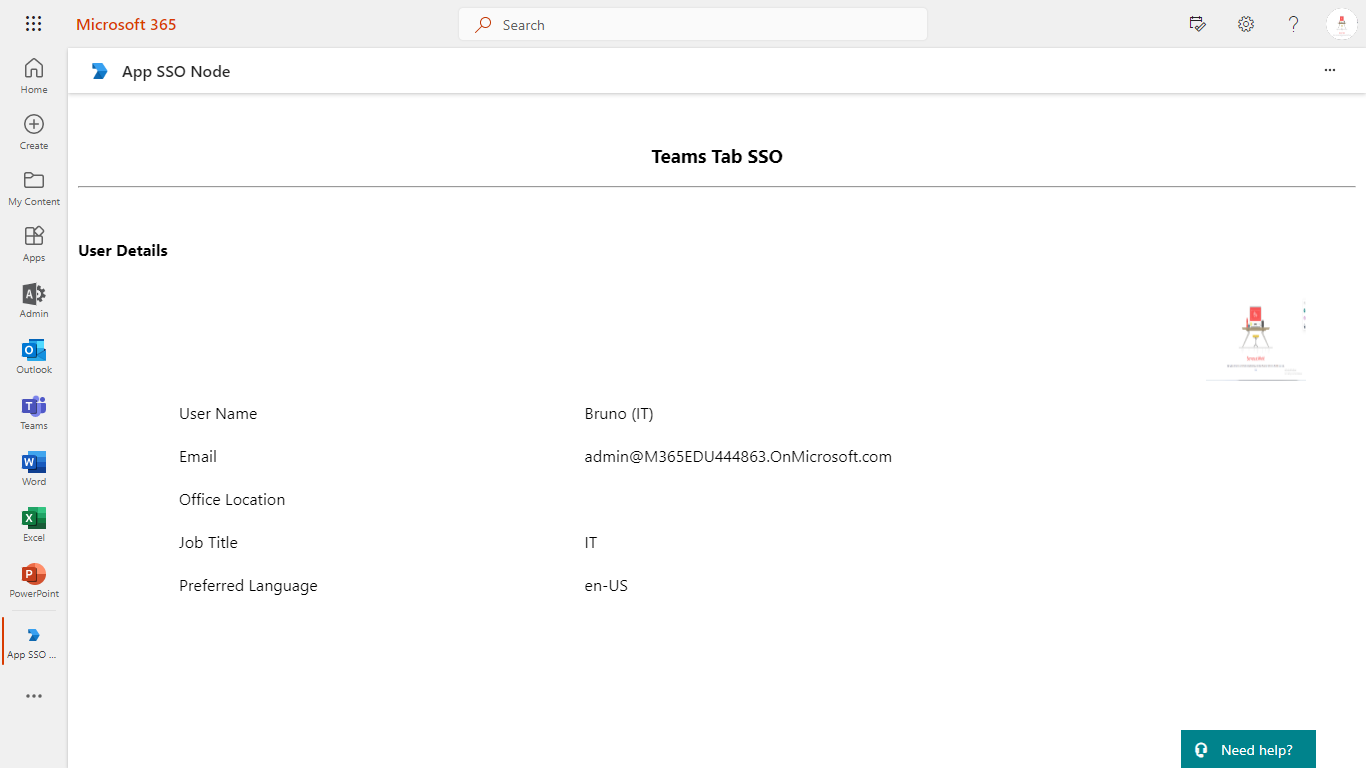
Note: Similarly, you can test your application in the Office 365 desktop app as well.
Deploy the bot to Azure
To learn more about deploying a bot to Azure, see Deploy your bot to Azure for a complete list of deployment instructions.
Further reading
- Bot Framework Documentation
- Bot Basics
- SSO for Bot
- SSO for Messaging Extensions
- SSO for Tab
- Azure Portal
- Add Authentication to Your Bot Via Azure Bot Service
- Azure Bot Service Introduction
- Azure Bot Service Documentation
- Extend Teams apps across Microsoft 365